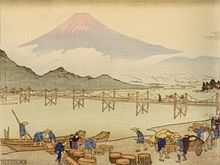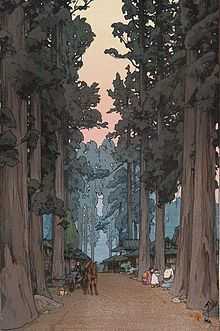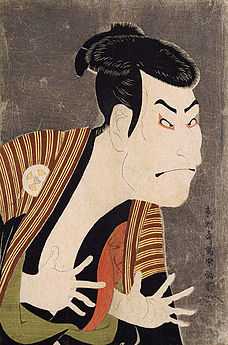Shin-hanga
_Yokugo_no_onna_(cropped_and_compressed)_01.jpg)



Shin-hanga (新版画, lit. "new prints", "new woodcut (block) prints") was an art movement in early 20th-century Japan, during the Taishō and Shōwa periods, that revitalized traditional ukiyo-e art rooted in the Edo and Meiji periods (17th–19th century). It maintained the traditional ukiyo-e collaborative system (hanmoto system) where the artist, carver, printer, and publisher engaged in division of labor, as opposed to the sōsaku-hanga (creative prints) movement which advocated the principles of "self-drawn" (jiga), "self-carved" (jikoku) and "self-printed" (jizuri), according to which the artist, with the desire of expressing the self, is the sole creator of art.
The movement flourished from around 1915 to 1942, though it resumed briefly from 1946 through the 1950s. Inspired by European Impressionism, the artists incorporated Western elements such as the effects of light and the expression of individual moods, but focused on strictly traditional themes of landscapes (fukeiga), famous places (meishō), beautiful women (bijinga), kabuki actors (yakusha-e), and birds and flowers (kachōga).
History
The term shin-hanga was coined in 1915 by Watanabe Shōzaburō (1885-1962), the most important publisher of shin-hanga, with the aim of differentiating shin-hanga from the commercial mass art that ukiyo-e had been, though it was driven largely by exports to the United States.
Shin-hanga prints were directed to a Western audience largely through Western patronage and art dealers such as Robert O. Muller (1911-2003). Directed primarily to foreign markets, shin-hanga prints appealed to Western taste for nostalgic and romanticized views of Japan. Shin-hanga prints flourished and enjoyed immense popularity overseas. In the 1920s, there were articles on shin-hanga in the International Studio, the Studio, the Art News and the Art Digest magazines. In 1921, a Shinsaku-hanga Tenrankai (New Creative Print exhibition) was held in Tokyo. One hundred and fifty works by ten artists were exhibited. In 1930 and 1936, two major shin-hanga exhibitions were held at the Toledo Museum of Art in Ohio. They were the largest showcases of shin-hanga prints at the time.
Ironically, there was not much domestic market for shin-hanga prints in Japan. Ukiyo-e prints were considered by the Japanese as mass commercial products, as opposed to the European view of ukiyo-e as fine art during the climax of Japonisme. After decades of modernization/Westernization during the Meiji era, architecture, art and clothing in Japan came to follow Western modes. Japanese art students were trained in the Western tradition. Western oil paintings (yōga) were considered high art and received official recognition from the Bunten (The Ministry of Education Fine Arts Exhibition). Shin-hanga prints, on the other hand, were considered as a variation of the outdated ukiyo-e. They were dismissed by the Bunten and were subordinated under oil paintings and sculptures.
Shin-hanga declined as the military government tightened its control over the arts and culture during wartime. In 1939, the Army Art Association was established under the patronage of the Army Information Section to promote war art. By 1943, an official commission for war painting was set up and artists’ materials were rationed. Overseas market for Japanese prints declined drastically at the same time. Shin-hanga never regained its momentum in postwar Japan. Instead, sōsaku-hanga emerged as the genuine heir of the ukiyo-e woodblock tradition and enjoyed immense popularity and prestige in the international art scene.
Subject matter and technique
The nostalgic and romanticized views of Japan that shin-hanga artists offered reveal the ways artists perceive their own environment in the midst of transformation. Most shin-hanga landscape prints (which constitute seventy percent of shin-hanga prints) feature places that are obscure and tranquil. Artists such as Kawase Hasui (1883-1957) produced dreamlike qualities in their prints, yearning for rural roots and the warm wooden architecture that was disappearing in urban Tokyo.
Shin-hanga vs. Ukiyo-e
Shin-hanga is often defined as "neo-ukiyo-e" under the shadow of the ukiyo-e tradition. While shin-hanga prints retain much of the ukiyo-e tradition in terms of subject matter, they reveal vastly different techniques and sensibilities. Inspired by Western Realism, shin-hanga artists produce hybrids that combine modern design with traditional subjects. The use of naturalistic light, colored lines, soft colors, 3-dimensionality, deep space are artistic innovations that break with the ukiyo-e tradition.
Shin-hanga vs. Sōsaku-hanga
The shin-hanga movement is often defined in opposition to the sōsaku-hanga movement (creative print movement) that began in the 1910s. While sōsaku-hanga artists advocated the principles of "self-drawn" (jiga), "self-carved" (jikoku) and "self-printed" (jizuri), according to which the artist engages in artistic expression by involving himself in all stages of the printmaking process, shin hanga artists continued to collaborate with carvers, printers and publishers in print production. At the core of the shin-hanga and sōsaku-hanga dichotomy is the debate of what constitutes a creative print or pure art. Shin-hanga artists and publishers believed that their works were as creative as those produced by sōsaku-hanga artists. In 1921, Watanabe Shōzaburō even used the term shinsaku-hanga ("new made prints") to emphasize the creative aspects of shin-hanga.
In a larger context, the dichotomy between shin-hanga and sōsaku-hanga was but one of many tensions in the Japanese art scene during decades of modernization, Westernization and internationalization. Parallel to the shin-hanga/sōsaku-hanga antagonism was the polarization between Japanese paintings (nihonga) and Western paintings (yōga), along with the flowering of many artistic currents such as futurism, avant-garde, proletarian art, and the mingei (folk art) movement, all of which were actively seeking a voice in the art scene in the period from 1910 to 1935 before the rise of militarism in Japan.
Notable artists
- Itō Shinsui
- Kawase Hasui
- Hashiguchi Goyō
- Charles W. Bartlett
- Kaburagi Kiyokata
- Hirano Hakuhō
- Yoshida Hiroshi
- Ohara Koson
- Torii Kotondo
- Natori Shunsen
- Hiroaki Takahashi (also known as Shotei)
- Yamamura Toyonari
- Elizabeth Keith
- Fritz Capelari
- Shiro Kasamatsu
- Takeji Asano
- Koichi Okada
- Tsuchiya Koitsu
- Ota Masamitsu (also known as Ota Gako)
Reference and Further Reading
- Blair, Dorothy. Modern Japanese prints: printed from a photographic reproduction of two exhibition catalogues of modern Japanese prints published by the Toledo Museum of Art in 1930-1936. Ohio: Toledo Museum of Art, 1997.
- Brown, K. and Goodall-Cristante, H. Shin-Hanga: New Prints in Modern Japan. Los Angeles County Museum of Art, 1996. ISBN 0-295-97517-2
- Hamanoka, Shinji. Female Image: 20th Century Prints of Japanese Beauties. Hotei Publishing 2000. ISBN 90-74822-20-7
- Jenkins, D. Images of a Changing World: Japanese Prints of the Twentieth Century. Portland: Portland Art Museum, 1983. ISBN 0-295-96137-6
- Menzies, Jackie. Modern boy, Modern Girl: Modernity in Japanese Art 1910-1935. Sydney, Australia: Art Gallery NSW, c1998. ISBN 0-7313-8900-X
- Merritt, Helen and Nanako Yamada. (1995). Guide to Modern Japanese Woodblock Prints, 1900-1975. Honolulu: University of Hawaii Press. 10-ISBN 082481732X/13-ISBN 9780824817329; 10-ISBN 0824812867/13-ISBN 9780824812867; OCLC 247995392
- Merritt, Helen. Modern Japanese Woodblock Prints: The Early Years. Honolulu: University of Hawaii Press 1990. ISBN 0-8248-1200-X
- Mirviss, Joan B. Printed to Perfection: Twentieth-century Japanese Prints from the Robert O. Muller Collection. Washington D.C.: Arthur M. Sackler Gallery, Smithsonian Institution and Hotei Publishing 2004. ISBN 90-74822-73-8
- Newland, Amy Reigle. (2005). Hotei Encyclopedia of Japanese Woodblock Prints. Amsterdam: Hotei. 10-ISBN 9074822657/13-ISBN 9789074822657; OCLC 61666175
- Smith, Lawrence. Modern Japanese Prints 1912-1989. New York, London, Paris: Cross River Press, 1994.
- Swinton, Elizabeth de Sabato. Terrific Tokyo: A panorama in Prints from the 1860s to the 1930s. Worcester: Worcester Art Museum, 1998. ISBN 0-936042-00-1
- Masuda, Koh. Kenkyusha's New Japanese-English Dictionary, Kenkyusha Limited, Tokyo 1991, ISBN 4-7674-2015-6
External links
| Wikimedia Commons has media related to Shin Hanga. |
- Shin hanga — Viewing Japanese Prints, a website by John Fiorillo
- Shin hanga — artelino - Art Auctions
- Side gallery of Hanga Gallery Information, print gallery,...
- Dream Worlds: Modern Japanese Prints and Paintings from the Robert O. Muller Collection (Online Exhibition)
- “What is a Print?” An excellent flash-demonstration of the printmaking process.
- www.AoiGallery.com - Shin Hanga Art Gallery
- Shin Hanga Prints by Takeji Asano
- - Robert O. Muller Information about the man behind one of the most well known collections of Shin Hanga.
| ||||||||||||||||||||
